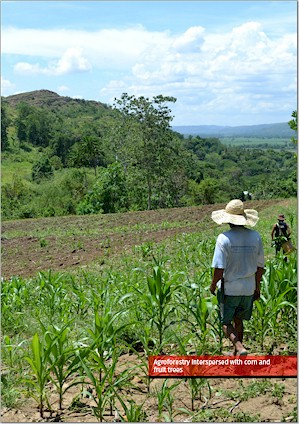| Book Chapter |
 |
|
| Title | Policy guidelines for agroforestry development adopted by ASEAN | | Author | Delia C. Catacutan, Robert Finlayson, Aulia Perdana, Betha Lusiana, Beria Leimona, Elisabeth Simelton, Ingrid Oborn, Gamma Galudra, James M Roshetko, Philippe Vaast, Rachmat Mulia, Rodel D. Lasco, Sonya Dewi, Simone Borelli and Yurdi Yasmi | | Editors | Meine van Noordwijk | | Year | 2019 | | Book Title | Sustainable development through trees on farms: agroforestry in its fifth decade | | Pages | 329-351 | | Call Number | BC00477-19 |
|
| Abstract: |
Getting agroforestry on negotiation tables where global, regional, national and local policy responses to current ‘issues’ are discussed takes patience and time. Yet, without such investment, flexibility in the language to be used, and persistence and consensus on the core aspects, agroforestry practitioners will continue to face hurdles because policy documents don’t refer to it as a potential contribution.
Considerable progress was made in recent years in the Southeast Asian context where ASEAN (the Association of Southeast Asian Nations) with its ten Member States engaged in a process of consultations that led to a set of principles and associated implementation guidelines were endorsed at Ministerial level. The document itself has no legal power (there are sanctions or dispute settlement rules), but serves as an expression of commitment and intent, and provides a framework for cooperation amongst Member States. It can help in dealing with cross-border issues as they exist on both the agricultural and forestry side of agroforestry. The principles and guidelines will offer little, if any, surprise for readers of the preceding chapters of this book, and indeed much of the research results reviewed here was summarized at the start of the policy process in a ‘white paper’1. Much of these guidelines can apply in other regions of the world, but as in any science-policy interface, the ‘boundary work’ of consultations and a participative process is as important for the legitimacy dimension of the resulting ‘boundary object’, as the credibility of the underlying evidence and the relevance (salience) of the recommended courses for action.
|
|
|
Download file(s): Click icon to download/open file.
|
| |
File Size |
Description |

|
1576 KB |
Softcopy |
|
|
|
| Viewed in 336 times. Downloaded in 239 times. |